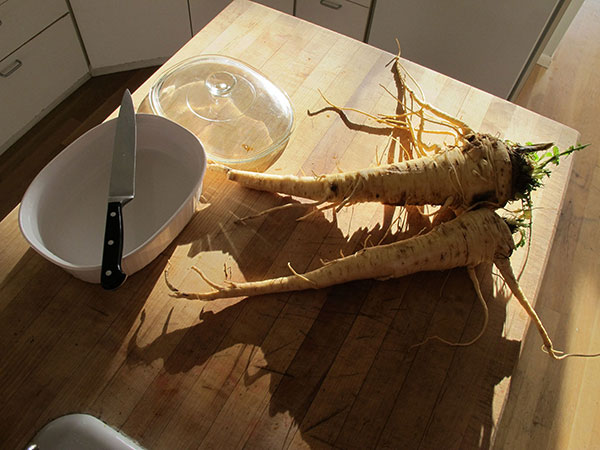Get Back to Your Roots This Winter

The parsnip is an overlooked root vegetable. It is like a carrot’s sweeter sister, and it can add a new dimension to your cooking. They taste great and because they are low in salt, they help protect your heart and kidneys.
Helpful during COVID-19 times when you want to minimize shopping, parsnips keep a long time in your refrigerator. If space is short in your refrigerator, a cool, dry place will work. I keep parsnips from the garden in my cold garage for weeks.
Parsnips are in season all winter. If you plant some this spring, they will keep through next winter. They get even sweeter after the first frost.
Try these recipes to get to know these wonderful vegetables.
Parsnip Harvest Casserole
3 tablespoon olive oil
1 pound parsnips
1 tablespoon fresh thyme or 1 teaspoon dried thyme
1 teaspoon sugar
1 cup half-and-half or yogurt thinned with milk
1 pound tomatoes or cherry tomatoes, sliced
1 tablespoon fresh oregano or 1 teaspoon dried oregano
1½ cups grated cheddar or mozzarella cheese
Heat oven to 350 degrees. Peel parsnips and slice them into quarter inch slices. If slices are large, cut them in half. Cook in a skillet with oil, thyme, and sugar for 5–7 minutes, or until golden and softened.
Grease a small casserole or baking pan with non-stick cooking spray. Spread half the parsnips over the bottom of the dish. Add half the tomatoes as the next layer. Sprinkle with cheese. Add another layer of parsnips and tomatoes, followed by the rest of the cheese. Mix oregano with half-and-half or thinned yogurt, then pour over dish. Cover with lid or foil and bake for 40 minutes or until tender. Remove cover and brown a few more minutes.
Nutritional information:
Calories: 159, Carbohydrates: 12 grams, Protein: 6 grams, Sodium: 19 milligrams
Roasted Parsnips
3–4 large parsnips, peeled and sliced about a quarter inch thick
8 cloves garlic
½ onion, sliced
1 tablespoon fresh thyme or 1 teaspoon dried
3 tablespoons olive oil
3 tablespoons balsamic vinegar
Heat oven to 350 degrees. Put parsnips in casserole or baking dish, add a quarter cup water and cover with lid or foil. Bake 20–25 minutes. Meanwhile, sauté onion, garlic, olive oil, and thyme, and add to casserole dish. Remove cover and bake another 20–30 minutes or until tender. Toss with balsamic vinegar before serving.
Nutritional information:
Calories: 184, Carbohydrates: 30 grams, Protein: 2 grams, Sodium: 16 milligrams
Mashed Parsnips
3–4 large parsnips
3–4 large potatoes (russets are best)
Handful of fresh sage, thinly sliced
½ cup butter or margarine
½ cup sour cream, half-and-half, or yogurt
Peel parsnips. Cut out the woody cores if they are large. Put in microwavable dish and microwave 10–20 minutes. Meanwhile, cut potatoes in half, put into pot, and boil for 10–15 minutes or until tender. Drain well.
Sauté sage leaves in butter for 1–2 minutes. Put potatoes and parsnips in mixing bowl, whip with electric mixer or mash with potato masher, stirring in sage, butter, and sour cream or half-and-half. Makes eight servings.
Nutritional information: (per serving)
Calories: 420, Carbohydrate: 62 grams, Protein: 7 grams, Sodium: 215 milligrams
 Contributor Katy G. Wilkens is a registered dietitian and department head at Northwest Kidney Centers. The National Kidney Foundation Council on Renal Nutrition has honored her with its highest awards for excellence in education and for significant contributions in renal nutrition.
Contributor Katy G. Wilkens is a registered dietitian and department head at Northwest Kidney Centers. The National Kidney Foundation Council on Renal Nutrition has honored her with its highest awards for excellence in education and for significant contributions in renal nutrition.
![AgeWise King County [logo]](https://www.agewisekingcounty.org/wp-content/themes/agewisekingcounty/images/logo.png)